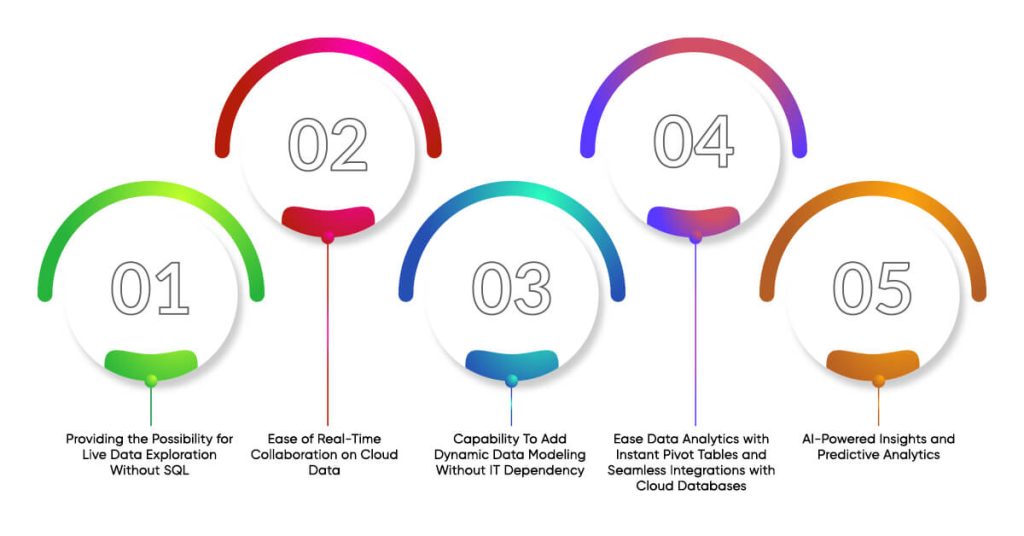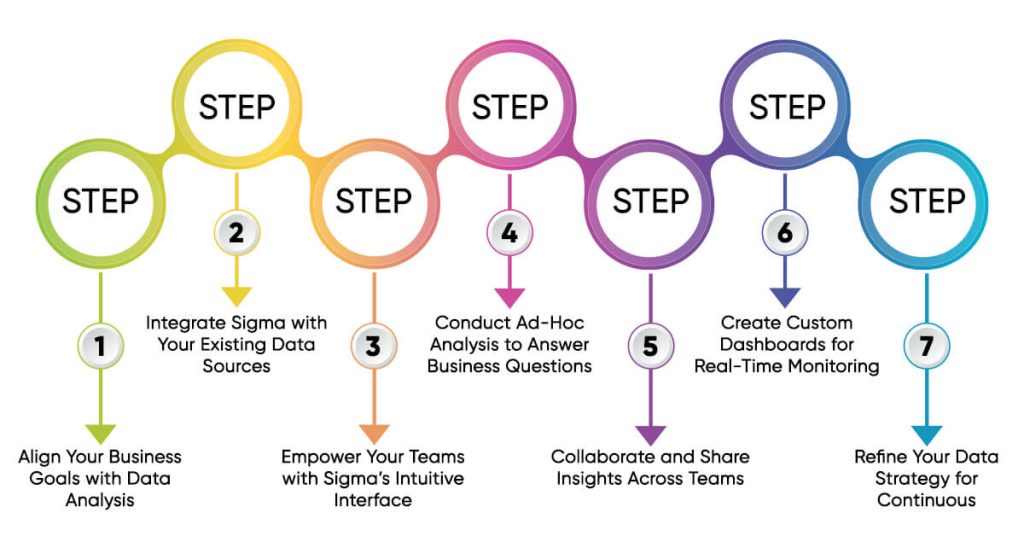Quick Summary
Sigma is a cloud-based analytics platform that combines spreadsheet simplicity with cloud data warehouse power. It enables users to explore live data without SQL knowledge through its familiar interface. Sigma is designed to scale to cloud volumes on live data. By connecting directly to cloud databases and supporting real-time analysis, Sigma helps organizations ease their data analytics processes for both technical and non-technical users.
The most difficult task for any organization that is taking strides toward becoming a data-driven organization is to align and train the whole team on BI and data analysis tools. While technical users can be trained, it is the non-technical users who find accessing complex data difficult and struggle with writing SQL queries or navigating traditional BI platforms.
The Sigma data analysis and computing platform helps solve these challenges for organizations by providing the convenience of analyzing data instantaneously through the Sigma interface without the need for extensive technical know-how.
This is why Sigma boasts of a solid active user base of nearly 200,000 who use it daily to gain insights from their cloud data warehouse and has had a staggering 350 million queries being performed on the platform till the first half of 2023.
What is Sigma Data Analysis?
What if you get a cloud-based platform or can incorporate cloud-based analytics tools that allow you to analyze vast amounts easily with a well-known spreadsheet-like interface? Sigma data analysis does exactly that and much more! Sigma is a game-changer in data analytics for organizations because of its cloud-native architecture, real-time collaboration, direct data warehouse access, and no-code/low-code interface.
We're the only platform that scales to cloud volumes on live data, merging spreadsheet simplicity with Python and SQL's power, and layering natural language on top to ensure that everyone in the enterprise can become a data analyst
Mike Palmer, Sigma CEO.
5 Ways in Which Sigma Simplifies Data Analysis

Sigma is termed as a business intelligence disruptor by Business Newswire because of the massive growth it has shown, with an annual recurring revenue of over 100% year-over-year. Let’s explore what makes Sigma a data analysis tool for business and what it is that makes SIgma an instant with organizations.
1. Providing the Possibility for Live Data Exploration Without SQL
The biggest advantage of Sigma is its ability to connect directly with cloud warehouses, removing the entire hassle and time involved in data extraction or pre-aggregation. What this means for the user is that they get access to live, real-time data instead of outdated ones.
Traditional data analysis tools and data analysis software needed users to write SQL queries, which was not apt for non-technical users who wanted to gain insights from data and use it. With Sigma data analysis, users can interact with familiar spreadsheet functions, which are then optimized into SQL queries in the background, making data exploration accessible and simple. The drag-and-drop fields to build queries, custom formulas, pre-built templates, reusable queries, and calculations that can be applied on the fly, filters, and ease of calculations without coding make Sigma a preferred data analysis tool.
2. Ease of Real-Time Collaboration on Cloud Data
What if you have a critical project at hand that needs the expertise of multiple stakeholders who are at different locations across the globe? Sigma, which is a cloud-native platform, makes it easy for your teams in real-time collaboration and decision-making by providing the ability to work simultaneously on live datasets, edit, visualize, and share insights in real-time, ensuring up-to-date decision-making without version control issues or the need for manual refreshes.
Additionally, Sigma scores brownie points with users for the comfortable and familiar interface it provides in the form of spreadsheets where multiple users can edit, explore, and filter data at the same time without overwriting while providing role-based permissions to ensure data integrity and security.
The future-centric capability to embed Sigma data analysis reports into apps and portals ensures that stakeholders always have access to the latest insights without needing to export static reports.
Additionally, you don’t lose any previous data or can keep track of the changes made as Sigma automatically allows for full data traceability and compliance by tracking changes, allowing users to revert to previous versions or review who made edits, thus reducing confusion and solving version control issues that commonly occur with excel-based workflows.
3. Capability To Add Dynamic Data Modeling Without IT Dependency
Employees already overloaded with critical tasks can be relieved from spending hours analyzing complex data with Sigma’s drag-and-drop tables, filters, and custom calculations. The functions like JOIN, UNION, and AGGREGATE can be performed visually, making it accessible to non-technical users. Additionally, like Excel, custom formulas and logic can be applied dynamically without affecting the underlying data warehouse, and reusable calculations, metrics, and logic can be created, which can also be shared across reports and dashboards, reducing duplication and ensuring consistency.
If you have ever found it difficult to join multiple datasets, Sigma can solve that. Sigma can help your team automatically recognize relationships between tables, making it easy to join multiple datasets without manual schema mapping. With Sigma data analysis incorporated into your enterprise, you can create data visualization of complex reports with multiple data sources effortlessly and define data permissions and security rules centrally.
Struggling to Make Data-Driven Decisions? Maximize Your Data Investments with X-Byte’s Expertise
4. Ease Data Analytics with Instant Pivot Tables and Seamless Integrations with Cloud Databases
What makes Sigma well-suited for busy businesses is the ease that its drag-and-drop capabilities provide. Sigma is an advanced data visualization tool that auto-generates pivot tables, charts, and graphs, making it a cakewalk for users and making it extremely easy to spot trends and patterns without manual data manipulation.
Sigma integrates seamlessly with popular cloud databases and platforms, including Snowflake, Amazon Redshift, Google BigQuery, PostgreSQL, Databricks, AlloyDB, Google Cloud Platform (GCP), and Amazon Web Services (AWS). The platform is designed to connect directly with cloud warehouses and can automatically recognize relationships between tables. This makes it easy to join multiple datasets without manual schema mapping. Most of the traditional data analysis tools require data extraction. When it comes to Sigma, it removes that hassle by directly running on cloud data warehouses. This makes the process super fast and delivers much-needed real-time insights.
5. AI-Powered Insights and Predictive Analytics
What if you can quickly identify outliers, trends, and forecasts without any sort of manual intervention? Sigma’s AI-driven suggestions and automated anomaly detection do exactly that. They help users to quickly identify these, setting new avenues for making quick, proactive decisions.
Sigma has NLP capabilities. Users can query data using natural language. Sigma’s AI interprets questions and presents results. It generates readable summaries of data insights for non-technical users. It further uses statistical models to forecast business metrics for future planning and has a What-If Analysis function– Models for different scenarios by adjusting variables to predict outcomes.
Benefits of Sigma in Data Analysis
- The biggest advantage of Sigma in data analysis is that it does not require extensive SQL knowledge, which helps companies as they do not need to hire extra developers, and the platform is extremely easy to use for non-technical users.
- Besides the ease of use, users can easily create data visualizations, custom reports, and dashboards without prior knowledge of SQL or other models.
- Sigma enables real-time team collaboration on datasets, improving cross-departmental decision-making.
- Automated reporting alerts teams about KPI changes without manual monitoring.
- Input Tables feature allows scenario modeling by combining user data with warehouse information.
- Sigma is also very easy to integrate with cloud warehouses.
- Sigma data analysis is also a potent tool that enables users to answer questions without extensive onboarding and training, opening up self-service capabilities for users, where they can create their custom reports.
- Additionally, it allows businesses to answer ad hoc questions, do calculations, and run formulas in Sigma.
A Step-by-Step Guide to Using Sigma for Data Analysis

Sigma’s simplified data analysis capabilities and user-friendly interface make it a powerful tool for data-driven decision-making and a key enabler for teams to explore, visualize, and act on insights without technical barriers. Here’s how businesses can team with companies that provide advanced data analytics services and data analysis solutions to help in step by incorporation of the Sigma analytics platform.
Step 1: Align Your Business Goals with Data Analysis
Haphazard implementation of data analysis strategy and incorporation of random data analysis software can fire big time, and having a crystal clear understanding of the broader business objectives is an essential and good starting point. Identifying the right metrics that will have the greatest impact on your business is the key. This is where you need the experience and expertise of a professional data analytics consultant who can make a data analysis plan that aligns with your strategic objectives, ensuring meaningful insights.
Our team of data engineers and analysts work in close quarters with you to understand your unique business needs and incorporate the Sigma analytics platform after understanding multiple facts like customer acquisition, profitability, etc. We identify your key performance indicators (KPIs) and business goals and ensure that your Data analysis software and data analysis strategy are directly tied to your company’s success.
Step 2: Integrate Sigma with Your Existing Data Sources
Do you feel bogged down by data from data sources like cloud-based databases, ERP systems, and CRMs and find yourself lost on the way to integrate Sigma? Then, you need a data consultant who can help you integrate Sigma with your existing data architecture. This will ensure that your data will always be accurate, real-time, and accessible for quick decision-making.
At X-Byte, we handle the full integration of the Sigma analytics platform with your current data sources, where our experts clean and prepare your data to ensure it’s ready for analysis, avoiding any disruption to your workflow.
Step 3: Empower Your Teams with Sigma’s Intuitive Interface
While incorporating the Sigma analytics platform is one part, training your teams is a different ball game altogether. The next natural progression involves guiding in-house teams on ways to navigate Sigma’s features.
With our hands-on training and ongoing support, we make sure that everyone, from marketing to operations, can utilize Sigma for impactful analysis.
Ready to Simplify your Data Analysis? Harness Sigma’s Potential with X-Byte’s Expertise
Step 4: Conduct Ad-Hoc Analysis to Answer Business Questions
What Sigma offers you is the capability to dig deep into your data and answer pressing business questions in real time. From analyzing customer behavior and sales trends to checking performance, Sigma uncovers actionable insights that can drive business decisions.
When you collaborate with X-Byte, you can gain from our experience and define the key questions and metrics that can help you make data-driven decisions. Our data analysts assist businesses and their teams in customizing reports and queries to meet specific business need so that you have the answers at your fingertips.
Step 5: Collaborate and Share Insights Across Teams
When you are scaling your business, connecting different stakeholders and teams becomes a huge task. Sigma is a collaborative data platform that provides access to all and improves collaboration, sharing dashboards and reports with key stakeholders in real-time becomes a lot easier, and teams become aligned on the latest insights. With Sigma, everyone across the hierarchy can act on the data that matters most.
When you partner with X-Byte, you get the advantage of collaborative workflows within Sigma and get our experts’ help in setting up sharing protocols so that all stakeholders at all levels have access to the most up-to-date data.
Step 6. Create Custom Dashboards for Real-Time Monitoring
Monitoring your business performance in real-time has never been easier with the Sigma analytics platform. At X-Byte, we are known for helping provide digital-first experiences and employing best practices for using Sigma through the design of personalized dashboards that highlight your critical KPIs and make it easy to track trends, compare performance, and identify areas for improvement.
Step 7: Refine Your Data Strategy for Continuous Improvement
Using the Sigma analytics platform for data analysis is not a do-it-once-and-forget kind of task, it’s an ongoing journey. Continuously refining your data strategy is a key component to ensure that your analysis stays aligned with your evolving business goals.
As a company providing cutting-edge data solutions, we are committed to helping our clients conduct regular reviews of their data strategy so that it remains aligned with the long-term business objectives.
Supercharge Your Business with the Power of Sigma
The real value for any business lies in using the data generated in the best way possible. The real value for businesses lies in using Sigma’s data analysis capabilities. Implementing and harnessing the potential of Sigma depends on expertise, training, and ongoing support. At X-Byte Analytics, we help our clients get the value out of data initiatives and use Sigma to its full potential.
If you are ready to take the next step towards becoming a scalable data-driven organization, then get in touch with our team of data experts.
Contact us today to schedule a consultation and start your journey toward data-driven success with Sigma.






